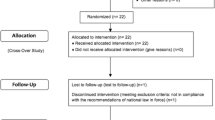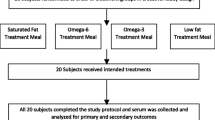Abstract
The advantages of administering intravenous fat emulsions are well known. Primarily, they are important sources of essential fatty acids; they allow the administration of many calories within a small volume; and they are isotonic compared to body fluid. In this review, the metabolic distinctiveness of parenterally infused fat particles in the bloodstream is evaluated under four main headings: (1) the structure and metabolism of fat emulsion particles; (2) the metabolism of phospholipid-rich fat emulsion; (3) the interactions between fat emulsion particles and plasma lipoproteins; and (4) the acquisition of protein moieties (apolipoproteins) by fat emulsion particles and its clinical implications.
Similar content being viewed by others
References
Dudrick SJ, Wilmore DW, Vars HM, Rhoads JE (1968) Long-term parenteral nutrition with growth, development, and positive nitrogen balance. Surgery 64:134–142
Olivecrona T, Bengtsson-Olivecrona G (1990) Lipase involved in lipoprotein metabolism. Curr Opin Lipidol 1:116–121
Peterson J, Bihain BE, Bengtsson-Olivecrona G, Deckelbaum RJ, Carpentier YA, Olivecrona T (1990) Fatty acid control of lipoprotein lipase: a link between energy metabolism and lipid transport. Proc Natl Acad Sci USA 87:909–913
Iriyama K, Kusaka N, Nishiwaki H, Teranishi T, Mori H, Suzuki H (1986) Metabolism of non-protein energy substrates in septic rats receiving parenteral nutrition. Int Surg 71:5–8
Spilmann D, Bracco U, Traitler H, Grozier G, Holman R, Ward M, Cotter R (1988) Alternative lipids to usual omega-6 PUFAS: gamma-linolenic acid, alpha-linolenic acid, stearidonic acid, EPA, etc. JPEN 12[Suppl to VI]:111S
Robinson DR, Tateno S, Patel B, Hirai A (1988) Lipid mediators of inflammatory and immune reactions. JPEN 12[Suppl to VI]:37S
Zipser RD, Kaffi G (1985) Prostaglandins, thomboxanes and leukotrienes in clinical medicine. West J Med 143:485–497
Moncada S, Vane JR (1979) Arachidonic acid metabolites and the interactions between platelets and blood vessel walls. N Engl J Med 300:1142–1147
Rodemann HP, Goldberg AL (1982) Arachidonic acid, prostaglandin E2 and F2-alpha, influence rates of protein turnover in skeletal and cardiac muscle. J Biol Chem 257:1632–1638
Baracos V, Rodemann HP, Dinarello CA, Goldberg AL (1983) Stimulation of muscle protein. Degradation and prostaglandin E2 release of leucocyte pyrogen (interleukin-1). N Engl J Med 308:553–558
Moncada V, Ferreira SH, Vane JR (1975) Inhibition of prostaglandin biosynthesis as the mechanism of analgesia of aspirin-like drugs in the dog knee joint. Eur J Pharmacol 31:250–260
Griffin E, Beckenridge WC, Kuksis A, Bryan MH, Angel A (1978) Appearance and characterization of lipoprotein X during continuous Intralipid infusions in the neonate. J Clin Invest 64:1703–1712
Untracht S (1982) Alterations of serum lipoproteins resulting from total parenteral nutrition with Intralipid. Biochim Biophys Acta 711:176–192
Tashiro T, Mashima Y, Yamamori H, Okui K (1986) Alteration of lipoprotein profile during total parenteral nutrition with Intralipid 10%. JPEN 10:622–626
Carpentier YA, Richelle M, Bury J, Bihain BE, Olivecrona T, Deckelbaum RJ (1987) Phospholipid excess of fat emulsion slows triglyceride removal and increases lipoprotein remodelling. Arteriosclerosis 7:541a-541a
Carlson LA, Hallberg D (1963) Studies on the elimination of exogenous lipids from the blood stream. The kinetics of the elimination of a fat emulsion and of chylomicrons in the dog after single injection. Acta Physiol Scand 59:52–61
Wretlind A (1981) Development of fat emulsion. JPEN 5:230–235
Carpentier YA (1989) Intravascular metabolism of fat emulsion. Clin Nutr 8:115–125
Asami H, Iriyama K (1990) In vitro transfer of apolipoproteins from plasma lipoproteins to artificial lipid particles. Nutrition 6:143–145
Iriyama K, Nishiwaki H, Asami H, Tonouchi H, Asakawa T, Miki C, Carpentier YA (1987) Influences of surgical trauma on the rate of transfer of apolipoprotein CII between artificial lipid particles and lipoproteins. Surg Res Commn 2:89–95
Iriyama K, Nishiwaki H, Terashima H, Tonouchi H, Miki C, Suzuki H, Carpentier YA (1988) Apolipoprotein C-II modifications associated with an infusion of artificial lipid particles. JPEN 12:60–62
Tonouchi H, Iriyama K, Carpentier YA (1990) Transfer of apolipoproteins between plasma lipoproteins and exogenous lipid particles after repeated bolus injections or during a continuous infusion of fat emulsion. JPEN 14:381–385
Iriyama K, Carpentier YA (1994) Clinical significance of transfer of apolipoproteins between triacylglycerol-rich particles in lipid emulsions and plasma lipoproteins. Nutrition 10:252–254
Iriyama K, Tonouchi H, Azuma T, Suzuki H, Carpentier YA (1991) Capacity of high-density lipoprotein for donating apolipoproteins to fat particles in hypertriglyceridemia induced by fat infusion. Nutrition 7:355–357
Nugent KM (1984) Intralipid effects on reticuloendothelial function. J Leukoc Biol 36:123–132
Hamawy KJ, Moldawer LL, Geogrieff M, Valicenti AJ, Babayan VK, Bistrian BR, Blackburn GL (1985) The effect of lipid emulsions on reticuloendothelial system function in the injured animal. JPEN 9:559–565
Hioki T, Teranishi T, Iriyama K (1988) Inhibitory effects of an intravenous infusion of large doses of lipid emulsion on clearance of endotoxin in rats. Mie Med J 38:43–46
Paulsrud JR, Pensler L, Witten CF, Stewart S, Holman RT (1972) Essential fatty acid deficiency in infants induced by fat-free intravenous feeding. Am J Clin Nutr 25:897–903
White HB, Turner JD, Turner AC, Miller RC (1973) Blood lipid alterations in infants receiving intravenous fat-free alimentation. J Pediatr 83:305–309
Muscaritoli M, Cangiono C, Cascino A, Caputo V, Serra P, Fanelli F (1986) Exogenous lipid clearance in compensated liver cirrhosis. JEPN 10:599–603
Glynn MJ, Powell-Tuck J, Reavely DA, Murray-Lyon IM (1988) High lipid parenteral nutrition improves portasystemic encephalopathy. JPEN 12:457–461
Tonouchi H, Iriyama K, Suzuki H (1990) Intravascular hydrolysis of exogenous lipid and its capacity for binding apoprotein C-II in patients with cirrhosis of the liver. Surg Res Commun 7:127–134
MacFie J, Nordenstrom J (1992) Full circle in parenteral nutrition. Clin Nutr 11:237–239
Nordenström J, Jeppson B, Loven L, Larsson J (1991) Peripheral parenteral nutrition: effect of a standardised compound mixture on infusion phlebitis. Br J Surg 78:1391–1394
Nordentröm J, Askanazi J, Elwyn DH, Marin P, Carpentier YA, Robin A, Kinney JM (1983) Nitrogen balance during total parenteral nutrition; glucose vs. fat. Ann Surg 197:24–33
Iriyama K, Nishiwaki H, Kusaka N, Teranishi T, Mori H, Suzuki H (1985) Nitrogen-sparing effect of lipid emulsion in septic dogs. Jpn J Surg 15:321–323
Nordenström J, Jeevanandam M, Elwyn DH (1981) Increasing glucose intake during total parenteral nutrition increases norepinephrine excretion in trauma and sepsis. Clin Physiol 1:525–534
Iriyama K, Kihata M, Asami H, Azuma T, Suzuki H (1989) Inhibitory effects of exogenous insulin on oxidative utilization of glucose in septic rats. Int Surg 74:81–83
Iriyama K, Teranishi T, Mori H, Nishiwaki H, Kusaka N (1984) Effects of exogenous catecholamines on glucose and fat metabolism and on triglycerides in the rat liver during total parenteral nutrition. JPEN 8:412–415
Robinson DR, Tateno S, Patel B, Hirai A (1988) Lipid mediators of inflammatory and immune reactions. JPEN 12[Suppl to VI]:37S-42S
Wan JMF, Teo TC, Babayan VK, Blackburn GL (1988) Lipids and the development of immune dysfunction and infection. JPEN 12[Suppl to VI]:43S-48S
Skeie B, Askanazi J, Rothkopf M, Rosenbaum SH, Kvetan V, Thomashow B (1988) Intravenous fat emulsions and lung function: a review. Crit Care Med 16:183–194
Lokesh BR, Black JM, German B, Kinsella JE (1988) Docosahexaenoic polyunsaturated fatty acids suppress leukotriene synthesis by mouse peritoneal macrophages. Lipids 23:968–972
Harris PL, Embree ND (1963) Quantitative consideration of the effect of polyunsaturated fatty acid content of the diet upon the requirements for vitamin E. Am J Clin Nutr 13:385–392
Lewis JS, Pian AK, Baer MT (1973) Effect of long-term ingestion of polyunsaturated fat, age, plasma cholesterol, diabetes mellitus and supplemental tocopherol upon plasma tocopherol. Am J Clin Nutr 36:136–143
Mascioli EA, Randall S, Porter KA, Kater G, Lopes S, Babayan VK, Blackburn GL, Bistrian BR (1991) Thermogenesis from intravenous medium-chain triglycerides. JPEN 15:27–31
Nakagawa M, Hiramatsu Y, Mitsuyoshi K, Yamamura M, Hioki K, Yamamoto M (1991) Effect of various lipid emulsions on total parenteral nutrition-induced hepatosteatosis in rats. JPEN 15:137–143
Mendez B, Ling PR, Istfan NW, Babayan VK, Bistrian BR (1992) Effects of different lipid sources in total parenteral nutrition on whole body protein kinetics and tumor growth. JPEN 16:545–551
Author information
Authors and Affiliations
Rights and permissions
About this article
Cite this article
Iriyama, K. The metabolic distinctiveness of emulsified lipid particles in the bloodstream and its clinical implications. Surg Today 26, 673–678 (1996). https://doi.org/10.1007/BF00312082
Received:
Accepted:
Issue Date:
DOI: https://doi.org/10.1007/BF00312082




